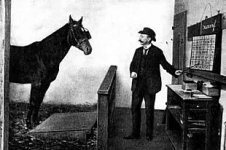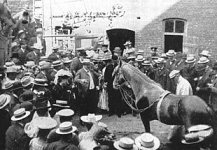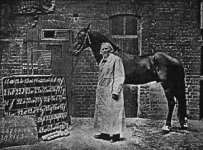♘امیرحسین♞
♘ مدیریت انجمن اسب ایران ♞
In the late 1800s, a German high school mathematics instructor named Wilhelm Von Osten was pushing a few scientific envelopes from his home in Berlin. Among other things, he was a student of phrenology, the now discredited theory that one's intelligence, character, and personality traits can be derived based of the shape of one's head. But it was his keen interest in animal intelligence that would ultimately win him fame.
Von Osten firmly believed that humanity had greatly underestimated the reasoning skills and intelligence of animals. To test his hypothesis, he took it upon himself to tutor a cat, a horse, and a bear in the ways of mathematics. The cat was indifferent to his efforts, and the bear seemed outright hostile, but the arab stallion named Hans showed some real promise. With further tutelage, Hans the horse learned to use his hoof to tap out numbers written on a blackboard. Much to Von Osten's delight, jotting a "3" on the blackboard would prompt a tap-tap-tap from his pupil, a feat which Hans could repeat for any number under ten.
Encouraged by this success, Von Osten pressed his student further. The scientist drew out some basic arithmetic problems on his chalkboard, and attempted to train the horse in the symbols' meanings. Hans had no problem keeping up with the curriculum, and soon he was providing the correct responses to a variety of math problems including basic square roots and fractions. Hans was proving to be a clever horse indeed.
Starting in 1891, Von Osten began parading "Clever Hans" all over Germany to show off the horse's mathematical proficiency. As word of the spectacle spread, Hans' free exhibitions began drawing larger and larger crowds of curious onlookers. They were seldom disappointed.
"If the first day of the month is a Wednesday," Von Osten would ask Hans, who had learned to respond to verbal questions, "what is the date of the following Monday?" Six hoof-taps would follow. "What is the square root of sixteen?" Four taps. Von Osten also explained to the astonished crowds that Hans could spell out words with taps, where one tap is an "A", two taps a "B", and so on. Hans would then demonstrate this talent by spelling out the names of people he knew, and responding to simple questions. He could also tap out the time of day. Though he made mistakes occasionally, his accuracy was found to be roughly 89%. By some estimates, Hans' grasp of mathematics was equivalent to a fourteen-year-old's.
Naturally there were many skeptics, particularly after the New York Times featured the crafty horse in a front-page story. Germany's board of education asked to conduct an independent investigation into Hans' abilities, and Von Osten agreed. He was a man of science, after all, and he knew that there was no fraud to expose. The board members assembled a number of scientific minds to join the Hans Commission, including two zoologists, a psychologist, a horse trainer, several school teachers, and a circus manager. Following extensive independent testing, the commission concluded in 1904 that there was no trickery involved in Hans' responses; as far as they could tell, the horse's talents were genuine.
The Hans Commission then passed the investigation on to Oskar Pfungst, a psychologist with some novel ideas on how to best unravel the mystery. Pfungst erected a large tent to house his experiments, thereby removing the contaminating effects of outside visual stimuli. In order to produce a sufficient data set, the scientist compiled a very large list of questions, and carefully outlined the different variables that were to be considered. Thus Pfungst began his interrogation of Hans.
As expected, Hans performed very well when questions were posed by his owner, Von Osten. He also received very high marks for accuracy with other questioners under normal conditions. But when the experiment called for the questioner to stand farther away, something interesting happened: the horse's accuracy diminished somewhat, though it wasn't immediately clear why.
It was the final two variables which proved to be the most revealing. In instances where the questioner didn't know the answer to a question in advance, the accuracy of Hans' responses plummeted to nearly zero. Likewise when the questioner was completely concealed from him. It seemed that Hans' cleverness hinged on his ability to have an up-close, unobstructed view of the person who knew the correct answer. The researchers also found evidence that hounding a horse with questions he can't answer leads to painful horse-bites.
Pfungst continued his experiments, but with a new emphasis on observing the humans interacting with Hans. The psychologist immediately noticed that each questioner's breathing, posture, and facial expression involuntarily changed each time the hoof tapped, showing ever-so-slight increases in tension. Once the "correct" tap was made, that subtle underlying tension suddenly disappeared from the person's face, which Hans apparently took as the cue to stop tapping. Pfungst also noticed that this tension was not present when the questioner was unaware of the correct answer, which left Hans without the necessary feedback.
Though the experiment strongly indicated that the horse probably had no real grasp of math, it did uncover an extraordinary insight. Hans wasn't dipping into a reservoir of intellect to work out the answers, he was merely being receptive to the subtle, unconscious cues which were universally present in his human questioners. There is evidence to indicate that horses may possess an enhanced sensitivity to inconspicuous body language, perhaps as a key part of their social interactions with other horses.
Once he became aware of these cues, Pfungst was able to rival Hans' accuracy by placing himself in the "horse" role, tapping out his answers to researchers' questions and keeping a sharp eye on their body language. Even more interestingly, he discovered that questioners seemed unable to suppress these subtle cues, even when made aware of them.
In the intervening years, it has been found that many animals are sensitive to such cues from their human masters. Today, the term "Clever Hans Effect" is used to describe the influence of a questioner's subtle and unintentional cues upon their subjects, in both humans and in animals. To prevent prejudices and foreknowledge from contaminating experimental results, modern science employs the double-blind method where researchers and subjects are unaware of many details of the experiment until after the results are recorded. For instance, when drug-sniffing dogs undergo training, none of the people present know which containers have drugs in them; otherwise their body language might betray the location and render the exercise useless.
Wilhelm Von Osten never really accepted the Clever Hans explanation, so he and his horse continued to put on their math-and-body-language show throughout Germany for some time. Throughout their career, the pair continued to draw large and enthusiastic crowds. Though Hans the horse knew nothing of math and had a flimsy grasp of German at best, his ability to fool so many people for so long clearly gives him a legitimate claim to cleverness. Considering his gifts in reading humans' unconscious tells, there's also little doubt that with some opposable thumbs and a stack of high society, Hans would have made one hell of a card player.
http://en.wikipedia.org/wiki/Clever_Hans
Von Osten firmly believed that humanity had greatly underestimated the reasoning skills and intelligence of animals. To test his hypothesis, he took it upon himself to tutor a cat, a horse, and a bear in the ways of mathematics. The cat was indifferent to his efforts, and the bear seemed outright hostile, but the arab stallion named Hans showed some real promise. With further tutelage, Hans the horse learned to use his hoof to tap out numbers written on a blackboard. Much to Von Osten's delight, jotting a "3" on the blackboard would prompt a tap-tap-tap from his pupil, a feat which Hans could repeat for any number under ten.
Encouraged by this success, Von Osten pressed his student further. The scientist drew out some basic arithmetic problems on his chalkboard, and attempted to train the horse in the symbols' meanings. Hans had no problem keeping up with the curriculum, and soon he was providing the correct responses to a variety of math problems including basic square roots and fractions. Hans was proving to be a clever horse indeed.
Starting in 1891, Von Osten began parading "Clever Hans" all over Germany to show off the horse's mathematical proficiency. As word of the spectacle spread, Hans' free exhibitions began drawing larger and larger crowds of curious onlookers. They were seldom disappointed.
"If the first day of the month is a Wednesday," Von Osten would ask Hans, who had learned to respond to verbal questions, "what is the date of the following Monday?" Six hoof-taps would follow. "What is the square root of sixteen?" Four taps. Von Osten also explained to the astonished crowds that Hans could spell out words with taps, where one tap is an "A", two taps a "B", and so on. Hans would then demonstrate this talent by spelling out the names of people he knew, and responding to simple questions. He could also tap out the time of day. Though he made mistakes occasionally, his accuracy was found to be roughly 89%. By some estimates, Hans' grasp of mathematics was equivalent to a fourteen-year-old's.
Naturally there were many skeptics, particularly after the New York Times featured the crafty horse in a front-page story. Germany's board of education asked to conduct an independent investigation into Hans' abilities, and Von Osten agreed. He was a man of science, after all, and he knew that there was no fraud to expose. The board members assembled a number of scientific minds to join the Hans Commission, including two zoologists, a psychologist, a horse trainer, several school teachers, and a circus manager. Following extensive independent testing, the commission concluded in 1904 that there was no trickery involved in Hans' responses; as far as they could tell, the horse's talents were genuine.
The Hans Commission then passed the investigation on to Oskar Pfungst, a psychologist with some novel ideas on how to best unravel the mystery. Pfungst erected a large tent to house his experiments, thereby removing the contaminating effects of outside visual stimuli. In order to produce a sufficient data set, the scientist compiled a very large list of questions, and carefully outlined the different variables that were to be considered. Thus Pfungst began his interrogation of Hans.
As expected, Hans performed very well when questions were posed by his owner, Von Osten. He also received very high marks for accuracy with other questioners under normal conditions. But when the experiment called for the questioner to stand farther away, something interesting happened: the horse's accuracy diminished somewhat, though it wasn't immediately clear why.
It was the final two variables which proved to be the most revealing. In instances where the questioner didn't know the answer to a question in advance, the accuracy of Hans' responses plummeted to nearly zero. Likewise when the questioner was completely concealed from him. It seemed that Hans' cleverness hinged on his ability to have an up-close, unobstructed view of the person who knew the correct answer. The researchers also found evidence that hounding a horse with questions he can't answer leads to painful horse-bites.
Pfungst continued his experiments, but with a new emphasis on observing the humans interacting with Hans. The psychologist immediately noticed that each questioner's breathing, posture, and facial expression involuntarily changed each time the hoof tapped, showing ever-so-slight increases in tension. Once the "correct" tap was made, that subtle underlying tension suddenly disappeared from the person's face, which Hans apparently took as the cue to stop tapping. Pfungst also noticed that this tension was not present when the questioner was unaware of the correct answer, which left Hans without the necessary feedback.
Though the experiment strongly indicated that the horse probably had no real grasp of math, it did uncover an extraordinary insight. Hans wasn't dipping into a reservoir of intellect to work out the answers, he was merely being receptive to the subtle, unconscious cues which were universally present in his human questioners. There is evidence to indicate that horses may possess an enhanced sensitivity to inconspicuous body language, perhaps as a key part of their social interactions with other horses.
Once he became aware of these cues, Pfungst was able to rival Hans' accuracy by placing himself in the "horse" role, tapping out his answers to researchers' questions and keeping a sharp eye on their body language. Even more interestingly, he discovered that questioners seemed unable to suppress these subtle cues, even when made aware of them.
In the intervening years, it has been found that many animals are sensitive to such cues from their human masters. Today, the term "Clever Hans Effect" is used to describe the influence of a questioner's subtle and unintentional cues upon their subjects, in both humans and in animals. To prevent prejudices and foreknowledge from contaminating experimental results, modern science employs the double-blind method where researchers and subjects are unaware of many details of the experiment until after the results are recorded. For instance, when drug-sniffing dogs undergo training, none of the people present know which containers have drugs in them; otherwise their body language might betray the location and render the exercise useless.
Wilhelm Von Osten never really accepted the Clever Hans explanation, so he and his horse continued to put on their math-and-body-language show throughout Germany for some time. Throughout their career, the pair continued to draw large and enthusiastic crowds. Though Hans the horse knew nothing of math and had a flimsy grasp of German at best, his ability to fool so many people for so long clearly gives him a legitimate claim to cleverness. Considering his gifts in reading humans' unconscious tells, there's also little doubt that with some opposable thumbs and a stack of high society, Hans would have made one hell of a card player.
http://en.wikipedia.org/wiki/Clever_Hans



